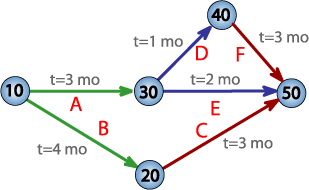border="1" |- ! header 1 ! header 2 ! header 3 |- | row 1, c[1]ell 1 | row 1, cell 2 | row 1, cell 3 |- | row 2, cell 1 | row 2, cell 2 | row 2, cell 3
|}Bold text
| This user page may require cleanup to meet Wikipedia's quality standards. No cleanup reason has been specified. Please help improve this user page if you can. |
--Toba4christ2000 (talk) 09:34, 16 May 2009 (UTC) THIS ANALYSIS IS CALLED CPA,IT IS A DETERMINISTIC MODEL.'Italic text

The Critical Path Method, abbreviated CPM, or Critical Path Analysis, is a mathematically based algorithm for scheduling a set of project activities. It is an important tool for effective project management.
It was developed in the 1950s by the Dupont Corporation at about the same time that General Dynamics and the US Navy were developing the Program Review and Evaluation Technique (PERT)[2] Today, it is commonly used with all forms of projects, including construction, software development, research projects, product development, engineering, and plant maintenance, among others. Any project with interdependent activities can apply this method of scheduling.
The essential technique for using CPM is to construct a model of the project that includes the following:
- A list of all activities required to complete the project (also known as Work breakdown structure),
- The time (duration) that each activity will take to completion, and
- The dependencies between the activities.
Using these values, CPM calculates the longest path of planned activities to the end of the project, and the earliest and latest that each activity can start and finish without making the project longer. This process determines which activities are "critical" (i.e., on the longest path) and which have "total float" (i.e., can be delayed without making the project longer). In project management, a critical path is the sequence of project network activities which add up to the longest overall duration. This determines the shortest time possible to complete the project. Any delay of an activity on the critical path directly impacts the planned project completion date (i.e. there is no float on the critical path). A project can have several, parallel, near critical paths. An additional parallel path through the network with the total durations shorter than the critical path is called a sub-critical or non-critical path.
These results allow managers to prioritize activities for the effective management of project completion, and to shorten the planned critical path of a project by pruning critical path activities, by "fast tracking" (i.e., performing more activities in parallel), and/or by "crashing the critical path" (i.e., shortening the durations of critical path activities by adding resources).
Originally, the critical path method considered only logical dependencies between terminal elements. Since then, it has been expanded to allow for the inclusion of resources related to each activity, through processes called activity-based resource assignments and resource leveling. A resource-leveled schedule may include delays due to resource bottlenecks (i.e., unavailability of a resource at the required time), and may cause a previously shorter path to become the longest or most "resource critical" path. A related concept is called the critical chain, which attempts to protect activity and project durations from unforeseen delays due to resource constraints.
THESE FORMULARS ARE USED IN PERT: (to+4tn+tp)/6 to calculate expected time. ONIYARABI PRESTIGE(NOTE FROM NIGERIAN UNIVERSITY)